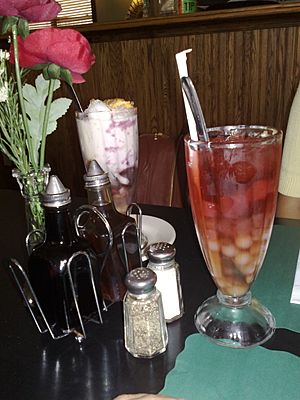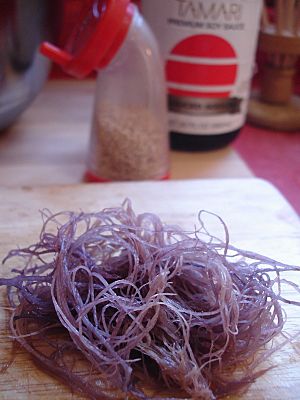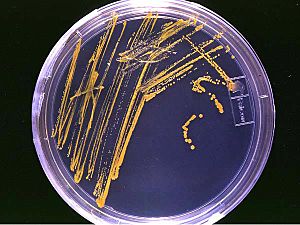Agar facts for kids
Agar or agar-agar is a jelly-like substance, obtained from algae. It was discovered in the late 1650s or early 1660s by Mino Tarōzaemon in Japan, where it is called kanten.
Agar is derived from the polysaccharide agarose, which forms the supporting structure in the cell walls of certain species of algae, and which is released on boiling. These algae are known as agarophytes and belong to the Rhodophyta (red algae) phylum.
For commercial purposes, it is derived primarily from Gelidium amansii. In chemical terms, agar is a polymer made up of sub units of the sugar galactose. Gelidium agar is used primarily for bacteriological plates. Gracilaria agar is used mainly in food applications
Culinary
Throughout history into modern times, agar has been used as an ingredient in desserts throughout Asia. Agar-agar is a natural vegetable gelatin counterpart. White and semi-translucent, it is sold in packages as washed and dried strips or in powdered form. It can be used to make jellies, puddings, and custards.

For making jelly, it is boiled in water until the solids dissolve. Sweetener, flavouring, colouring, fruit or vegetables are then added and the liquid is poured into molds to be served as desserts and vegetable aspics, or incorporated with other desserts, such as a jelly layer in a cake.
Agar-agar is approximately 80% fiber, so it can serve as an intestinal regulator. Its bulking quality has been behind fad diets in Asia, for example the kanten (the Japanese word for agar-agar) diet. Once ingested, kanten triples in size and absorbs water. This results in the consumers feeling fuller. This diet has recently received some press coverage in the United States as well. The diet has shown promise in obesity studies.
Agar (agar-agar) can be used as a laxative, an appetite suppressant, a vegetarian substitute for gelatin, a thickener for soups, in fruit preserves, ice cream, and other desserts and as a clarifying agent in brewing.
Agar-agar is an allowed nonorganic/nonsynthetic additive used as a thickener, gelling agent, texturizer, moisturizer, emulsifier, flavor enhancer, and absorbent in certified organic foods.
Microbiology

Agar was first used in microbiology in 1882 by the German microbiologist Walther Hesse, an assistant working in Robert Koch's laboratory, on the suggestion of his wife Angelina Fannie Eilshemius Hesse. He discovered that it was more useful as a solidifying agent than gelatin, due to its better solidifying temperature.
Agar was first subjected to chemical analysis in 1859 by the French chemist Anselme Payen, who had obtained agar from the marine algae Gelidium corneum.
An agar plate or Petri dish is used to provide a growth medium using a mix of agar and other nutrients in which microorganisms, including bacteria and fungi, can be cultured and observed under the microscope. Agar is indigestible for many organisms so that microbial growth does not affect the gel used and it remains stable.
Other uses
Agar is used:
- As an impression material in dentistry
- To make salt bridges and gel plugs for use in electrochemistry
- In formicariums as a transparent substitute for sand and a source of nutrition
- As a natural ingredient to form modelling clay for young children to play with
- As an allowed biofertilizer component in organic farming
Images for kids
-
A blood agar plate used to culture bacteria and diagnose infection
-
100mm (4") diameter Petri dishes containing agar gel for bacterial culture
-
Physcomitrella patens plants growing axenically in vitro on agar plates (Petri dish, 9 cm, 3½" diameter).
See also
 In Spanish: Agar-agar para niños
In Spanish: Agar-agar para niños







